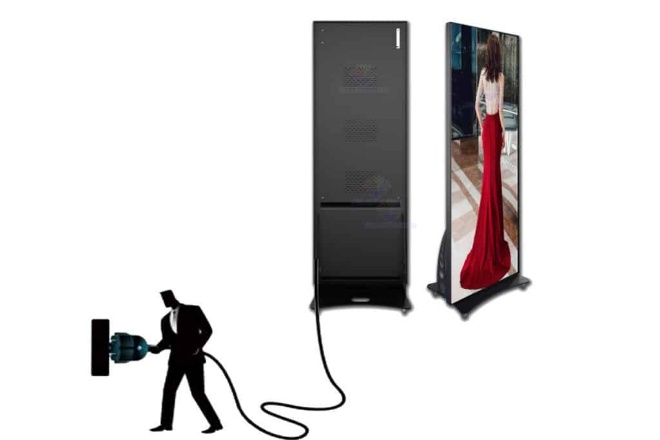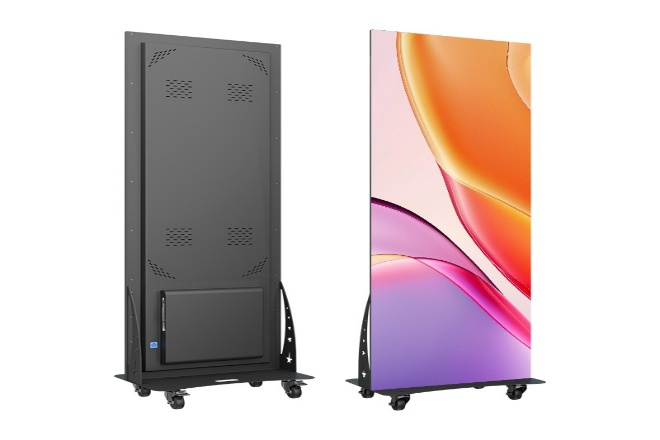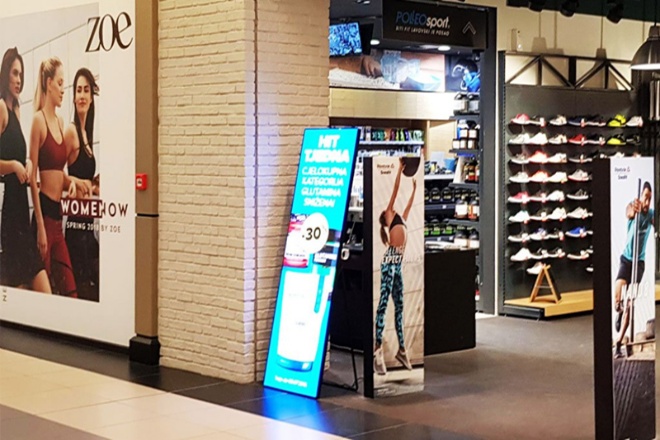Introduction
There are many types of LED display screens on the market now, and even Écrans d'affichage LED have plug-in and plug-in-free models. In the purchase process, the choice of power supply method often becomes a key consideration: Should you choose a stable and reliable poster screen with a plug-in style, or a convenient and flexible plug-in-free LED poster screen?
1. Simple understanding of LED poster screen

Imagine that you are walking in a bustling shopping mall, and suddenly, a colorful and vivid screen attracts your attention. That is the LED poster screen. It is like a high-tech picture frame that displays a variety of advertisements, product information, or event previews.
LED poster screens are not limited to shopping malls; they are also often seen in brand counters, event sites, cinemas, exposition halls, banks, hôpitaux, schools, and other places, becoming a little expert in conveying information and enhancing the atmosphere.
1). The internal structure and working principle of the LED poster screen:
Don’t be fooled by the bright and beautiful appearance of the LED poster screen, in fact, it also has a very structured structure.
Simply put, it is composed of a bunch of small LED lamp beads arranged and combined, and these lamp beads are the “pixels” of the display screen. Of course, it is not enough to have lamp beads alone; there must be a “brain” to control them, that is, the control circuit.
The control circuit receives information from the computer or other input devices and then commands the lamp beads to light up or go out to form the picture we see. As for the power supply, it is like the “rice bowl” of the LED poster screen, providing it with energy so that it can continue to work.
2. What are the advantages and limitations of the LED poster screen with a plug-in cable?

Speaking of the LED poster screen with a plug-in cable, we have to talk about its advantages that make people shine and, of course, those limitations that make people a little entangled.
1). Avantages :
- La stabilité:
The LED poster screen with a plug-in cable is like a steady big brother, directly connected to the power grid, and the power supply is stable. You don’t have to worry about it suddenly running out of power like a mobile phone, or flashing or black screen due to unstable voltage.
This is a blessing for scenes that require long-term continuous operation. For example, a shopping mall can always display the latest product information brightly and attract customers’ attention.
- Brightness and effect:
Did you know? The brightness and color saturation of the LED poster screen with a plug-in cable are not ordinarily strong. Even in direct sunlight outdoors or in an environment with particularly strong light, it can keep the picture clear and colorful.
It’s like you are wearing a pair of sunglasses and looking at the mobile phone screen under the scorching sun, and you can still see it clearly. Such an effect is very effective in enhancing the brand image and attracting customers’ attention.
- Coût de maintenance:
Although the LED poster screen with a plug-in cable is powerful, its maintenance cost is not high. On the one hand, the LED display screen itself is more energy-saving, and the electricity bill will naturally not be too high.
On the other hand, its structure is relatively simple, not easy to malfunction, and maintenance is much easier. It’s like you bought a durable car. Although you spend some money when buying it, it is worry-free and cost-effective to use. In the long run, it is still very cost-effective.
2). Limitations:
- Installation restrictions:
Although the LED poster screen with a plug-in cable is good, it is not so easy to install. You have to find a place with a power socket first, and then you have to consider how to wire it. If the location is not suitable, you may have to pull extra wires and install sockets, which not only increases the installation cost but also may affect the appearance.
It’s like you want to buy a big TV and hang it on the wall, but you find that there is no reserved socket on the wall, so you can only pull wires and punch holes helplessly, which is really a bit troublesome.
- Mobilité:
Once the LED poster screen with a plug is installed, it is difficult to move it again. Because it has to be plugged in to use it, you can’t take it with you anytime and anywhere like a mobile phone. This is a bit inconvenient for scenes that need to change the display location frequently or use it temporarily.
- Safety risks:
There is a plug-in wire, which means there is a wire connection, so you have to pay attention to waterproofing, moisture-proof, and electrical safety. Especially if it is installed outdoors or in a humid environment, you have to be more careful.
In case the wire is aging, damaged, or flooded, there is a risk of leakage and short circuit. This is like the electric kettle you use at home. If the plug is flooded or the wire is aging, you have to replace it quickly; otherwise, there will be big problems.
3. What are the advantages and challenges of the non-plug-in LED poster screen?

The non-plug-in LED poster screen sounds very high-tech and convenient. What are the advantages that make people shine, and what are the small challenges that need our attention? Don’t worry, let’s talk about it now.
1). Avantages :
- Portability:
The biggest highlight of the non-plug-in LED poster screen is that it has a built-in battery, and there is no need to drag a long wire like a traditional poster screen, find a socket, and wire it.
In this way, whether it is an indoor exhibition, outdoor activities, or a temporary meeting, you can easily take it with you and go. Imagine that you carry a lightbox with this screen in it, and you can start the display immediately after you put it on the site. Isn’t it a great feeling?
- Installation facile:
Speaking of installation, the non-plug-in LED poster screen is even more worry-free. Before installing the traditional poster screen, you have to wire and find an electrician. After a series of operations, it is time-consuming and laborious.
And the non-plug-in one? Basically, it is “put and use.” You find a suitable place, put the screen, turn it on, and use it; it’s so simple. This is a lifesaver for those scenarios that need to be deployed quickly and used temporarily!
- Sécurité:
Don’t forget that plug-free also means safer. Without exposed wires, there is no need to worry about wire aging, damage, leakage, short circuit, etc.
This kind of safety is particularly important in crowded places, such as exhibitions and shopping malls. Imagine that if there is a problem with the wires, it may cause a power outage at the least or a fire at the worst, which is troublesome.
2). Défi:
- Battery life:
However, plug-free also has its troubles, such as battery life. After all, the battery power is limited, and it needs to be charged or replaced after a period of use. If you are showing a critical moment and the battery suddenly runs out of power, it will be embarrassing.
Therefore, when using a plug-free LED poster screen, you must always pay attention to the battery power and prepare spare batteries or charging equipment in advance.
- Brightness and performance:
Because it is battery-powered, the brightness and performance of the plug-free LED poster screen may be limited. Especially in a bright environment, if the screen brightness is not enough, the audience may not be able to see the content clearly.
Moreover, the battery performance will gradually decline with the increase in usage time and charging times, which may affect the display effect and service life of the screen.
- Considérations relatives aux coûts :
Finally, we have to talk about the cost. Although the plug-in-free LED poster screen is convenient, high-quality batteries and charging equipment are not cheap. In this way, the initial investment cost may be higher than that of the traditional plug-in poster screen.
However, if you often need to move the display and deploy quickly, then this investment may be worth it. After all, the convenience and flexibility it brings to you are unmatched by traditional poster screens.
4. Selection basis: Customized decision based on needs
When we are faced with the decision of choosing an LED poster screen, it is actually like customizing a set of clothes that suits us. We have to choose according to our body shape, preferences, and occasions.
So, how do you choose the right one? We can carefully consider the four aspects of the usage scenario: budget considerations, flexibility requirements, and environmental factors.
1). Usage scenario: jendoor fixed display VS outdoor mobile promotion:
First of all, you have to think about where this poster screen is going to be used. If it is a fixed indoor display, such as billboards in shopping malls and exhibition information in museums, then plug-in LED poster screens may be more suitable because they are stable and reliable, with high brightness, good effect, and no need to worry about power issues.
But if it is outdoor mobile promotion, such as street promotions and music festivals, then you have to consider non-plug-in ones. They are light and easy to carry and can be used anytime and anywhere; how convenient!
2). Budget considerations: Balance between long-term operating costs and initial investment:
Next, we have to talk about money. The initial investment in plug-in LED poster screens may be lower, but in the long run, the electricity and maintenance costs are not small.
As for non-plug-in ones, although the initial investment will be higher due to batteries and charging equipment, in the long run, the electricity bill will be saved, and maintenance is relatively simple. So, you have to do the math to see which one is more cost-effective.
3). Flexibility requirements: Whether the display location needs to be changed frequently:
Then, you have to think about whether this poster screen needs to be moved frequently. If it is the kind that does not move all year round, then the plug-in type is good.
But if you often have to change places, for example, you are in this city today and go to that city tomorrow, then the non-plug-in type is much more flexible. After all, no one wants to have to toss wires, sockets, etc., every time you change places.
4). Environmental factors: Jhe impact of light conditions and weather conditions on equipment selection:
Finally, environmental factors cannot be ignored. If your poster screen has to be placed outdoors, the light conditions and weather conditions must be carefully considered. When the sun is strong, the screen brightness must be sufficient; otherwise, the audience cannot see clearly.
On rainy days, waterproofing and moisture-proofing must be done well. Otherwise, it will be troublesome if the equipment breaks down. At this time, the plug-in type may have to choose the one with high brightness, and waterproof measures must be taken. Although the non-plug-in type is light, it must also be selected to adapt to various harsh environments.
Conclusion
In summary, the choice of a plug-in or non-plug-in LED poster screen requires careful consideration of actual needs, budget, and long-term planning.
The plug-in type is suitable for long-term and stable display, while the non-plug-in type is more suitable for scenes with fast response and frequent movement.
Enfin, si vous souhaitez en savoir plus sur les écrans LED, veuillez nous contacter.
